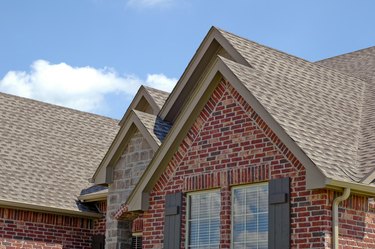
Building projects that involve brickwork have two main varieties to choose from: common brick and face brick. Both are durable and graded on a scale to match the building material with project needs. While there are differences between the two, the main difference is cosmetic. Face bricks are made to face the world with a smooth look. Common bricks are durable, but do not have smooth sides.
Brick Basics
Video of the Day
Bricks are an ancient and traditional building material, used both for strength and appearance. They are made from clay, molded into shape (traditionally 2-by-4-by-8 inches) and fired or baked in a kiln. The color, hardness, durability and structure of bricks vary with the type of clay used, as well as added materials such as silica, length of time fired and the temperature of the firing. Most bricks are broadly classified as either common, facing or "face," or according to their intended use, such as firebricks.
Video of the Day
Common Bricks Use Common Clay
Common bricks are made with basic brick clay, with no attempt at color control or special surface treatment. They may vary in color and texture within a single brick. Most are red, the color coming from iron content in the clay. Common bricks actually are a little bit smaller than average to allow for mortar joints to fill a 2-by-4-by-8-inch space, but these dimensions will actually vary slightly, depending on the manufacturer. Dimensions may even vary within groups of the same common brick. Sides are even but not completely smooth.
Put Your Best Face Forward
Face brick is more attractive than common bricks, with sides more accurately finished and smoothed. Colors also are more uniform, both within individual bricks and within brick lots in a shipment. Face brick can follow common brick sizing but also is produced in other dimensions for decorative purposes. Two of the more common variations are king and queen, with king being 2 inches longer than standard ones and queen being the same length but about 1/2 inch fatter.
Face Brick Comes in More Options
There are more color and texture options in face brick than in common brick. Some face bricks have one rough or "struck" face to be placed on the outside or "facing" surface; others have a ceramic glaze on one surface. Colors can vary from white or cream to yellow to red or brown or even almost black. Many face bricks are pressed bricks, made with a technique that compresses the clay and forms very smooth faces, sharp edges and perfectly square corners.
Make the Grade
All bricks, common or face, are graded for durability. Grade SW is Severe Weather, capable of withstanding freezing temperatures and harsh climates. MW is Medium, able to withstand freezing in less moist conditions. NW is not graded for most use outside but is intended for use in interior walls or applications in which it will be covered by face brick or other surfacing.
Uses for Both Bricks
Which one should you use? It comes down to the aesthetically pleasing look as well as durability. Common bricks are great for outdoor garden projects, low walls, repairs and patching, and other projects where there is not a need for a smooth face. You would not use a rough common brick on the exterior of a house or wall that will see a lot of traffic, since the rough edge would not make a comfortable surface to lean on or risk a scrape. Face bricks are used for projects that require the best look, such as front entryways, fireplaces and school buildings.